Explore The Serenity Of Wat Phnom Daun Penh On Your Trip To Cambodia In 2025
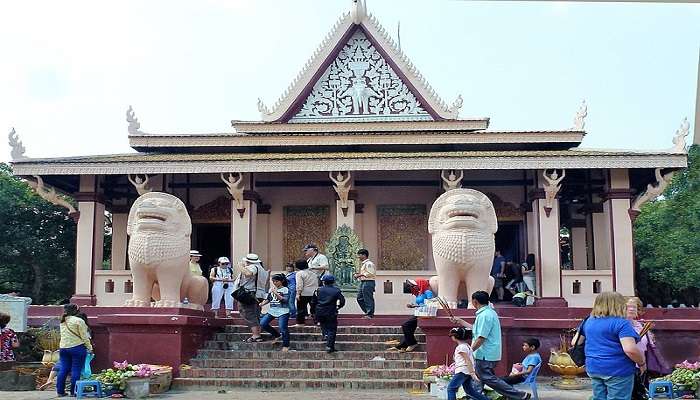
Perched on a gentle slope in central Phnom Penh, Wat Phnom Daun Penh is a cherished Buddhist temple with a long history. Legend has it that it was established in the 14th century when four Buddha statues were found in a tree trunk here. This significant discovery led to the temple’s construction, influencing the city’s name. Today, it continues to be a bustling centre for religious practices, attracting people who wish to connect with Cambodia’s cultural legacy. Its detailed architecture and peaceful ambience provide a refuge from the hustle and bustle of modern life.
Overview Of Wat Phnom Daun Penh
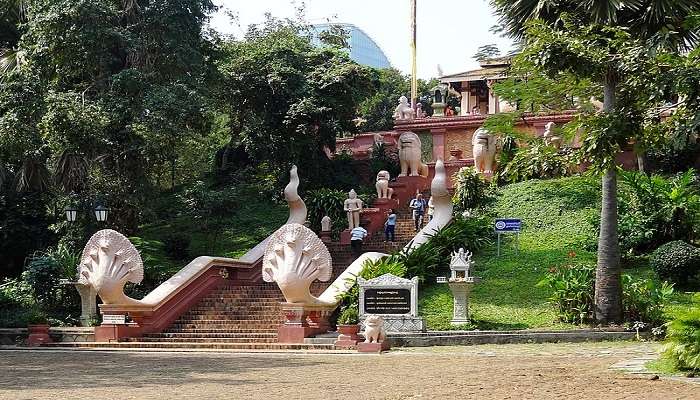
Wat Phnom Daun Penh, also known as Wat Phnom, is a significant Buddhist temple and historic site in Phnom Penh, Cambodia. Rising 46 meters above the city, it’s the sole hill in the area and lends its name to Phnom Penh.
According to legend, in 1372, a woman named Penh found five Buddha statues in a floating Koki tree. In honour of these sacred finds, she constructed a temple atop a man-made hill, giving birth to Wat Phnom. Over time, the temple has undergone numerous enhancements, becoming a central attraction beloved by locals and tourists alike. Wat Phnom offers a window into Cambodian heritage. It remains an active temple where one can observe Buddhist ceremonies and marvel at intricate sculptures and paintings. Climbing to its summit rewards visitors with sweeping views of the city, making it a must-visit spot on any Phnom Penh excursion.
Must Read: Cambodia Landmine Museum
History Of Wat Phnom Daun Penh
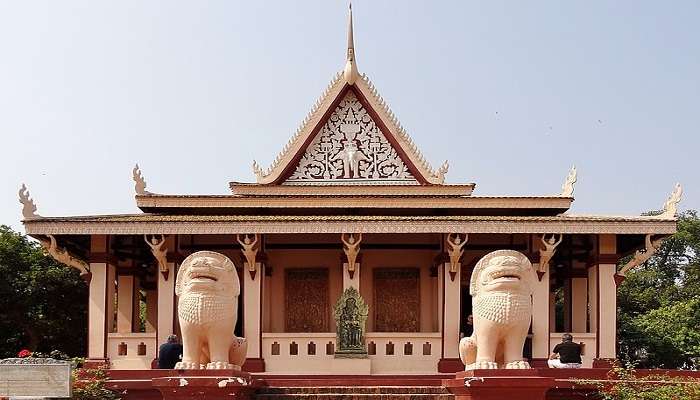
According to legend, there was a wealthy woman named ‘Penh’ who lived near the confluence of four rivers on a small hill. One rainy day while bathing at the port, Penh noticed a Koki tree floating in the river. She called villagers to retrieve it and, upon inspection, they found four Buddha statues made of bronze, brass, and marble inside the tree’s hollow. Another statue resembling Vishnu was also found, holding a staff, a chain, a snail, and a lotus flower. Penh directed the villagers to build an artificial hill and a wooden temple atop it to house the statues. Monks blessed the site, naming it “Wat Phnom.”
In the 15th century, during King Ponhea Yat’s reign (also known as Barom Reachea I), severe flooding forced the king to move his court. Chao Ponhea Decho, the governor of Samrong Tong Province, oversaw the construction of a new palace in Russey Keo village, where Wat Phnom stands today. The excavation for the palace created a lake, Boeung Decho. After its completion, King Ponhea Yat ordered the building of a hermitage atop the nearby mountain near Wat Phnom, named “Wat Phnom Daun Penh,” in honour of “Daun Penh.” This marked the beginning of the “Chaktomuk Period” of the Kingdom of Kampuchea in 1431. After the king’s death, a grand stupa was built in his memory at the summit of Wat Phnom.
Architecture Of Wat Phnom Daun Penh
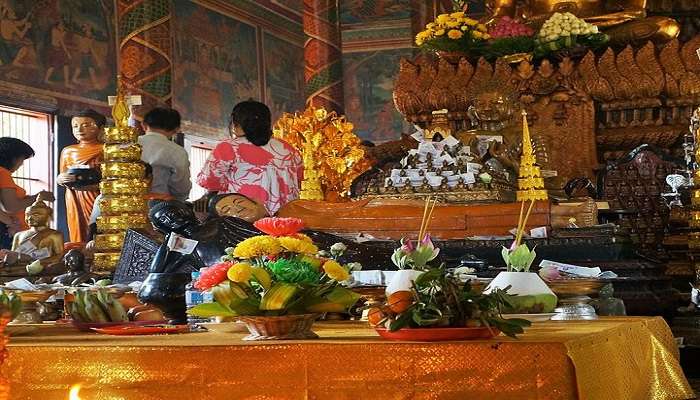
Wat Phnom Daun Penh’s architecture has undergone several reconstructions, notably in the 19th century and again in 1926. The sanctuary’s interior features a central altar complex adorned with a prominent bronze seated Buddha encircled by various statues, flowers, candles, and objects of reverence. Beautiful murals that tell stories from the Jataka tradition cover the walls, recounting the Buddha’s previous lives before his enlightenment. Additionally, murals narrating episodes from the Reamker, the Khmer rendition of the Ramayana, adorn the walls.
In the temple’s southwest corner, a small shrine stands in honour of Lady Penh, the legendary figure credited with the temple’s founding. This area is a hub of devotion, constantly bustling with devotees offering prayers and food as tokens of gratitude to the woman believed to have initiated the establishment of the wat. Their deep reverence and faith in Lady Penh’s significance is palpable, adding to the spiritual atmosphere of the Wat Phnom Temple.
Suggested Read: Tonle Sap Lake
Things To Do At Wat Phnom Daun Penh
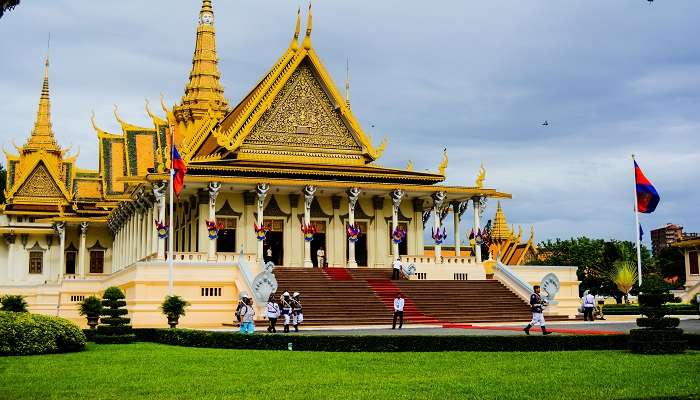
Besides seeing the architecture of Wat Phnom Cambodia, there are plenty of things. Some of the things to do at Wat Phnom Daun Penh are as follows:
- Fortune Telling: Wat Phnom is known for its fortune-telling, practised using Khmer divination tablets. To get your fortune reading, you shake a container with numbered sticks until one falls out. The fortune teller will then interpret the inscription on the corresponding numbered tablet, providing insights into your future, love life, or career. It’s important to remember that fortune-telling is a cultural experience and shouldn’t be taken too seriously.
- Sparrow Release: At Wat Phnom temple, vendors offer small sparrows for release into the wild. These birds, a symbol of liberation and good fortune, are a significant part of the temple’s cultural practices. Each cage, priced between USD 10 and USD 25, holds 15 to 25 sparrows.
- Visit the Stone Stupa: The main structure at Wat Phnom is the Stone Stupa, which holds four Buddha statues facing the four cardinal directions. Climbing the 262 steps to the top of the stupa will take you to a viewing platform with a panoramic view of Phnom Penh. The stupa enshrines seven hair relics of the Lord Buddha, brought to Cambodia in the 19th century. These are considered sacred objects, so the temple is an important pilgrimage site.
Wat Phnom Daun Penh Entrance Fees And Timings
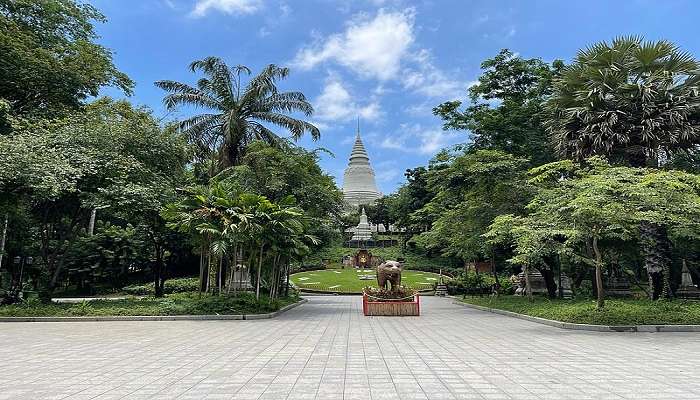
Wat Phnom Daun Penh welcomes visitors daily from 7:00 AM to 6:30 PM, offering ample time to explore its serene ambience and architectural wonders. Additionally, the museum within the complex is open during the same hours, providing a deeper insight into the site’s rich history and cultural significance. Wat Phnom entrance fee is priced at USD 1. At the same time, access to the museum requires a fee of USD 2, ensuring an affordable and enriching experience for all.
Suggested Read: Banteay Srei Cambodia
Best Time To Visit Wat Phnom Daun Penh
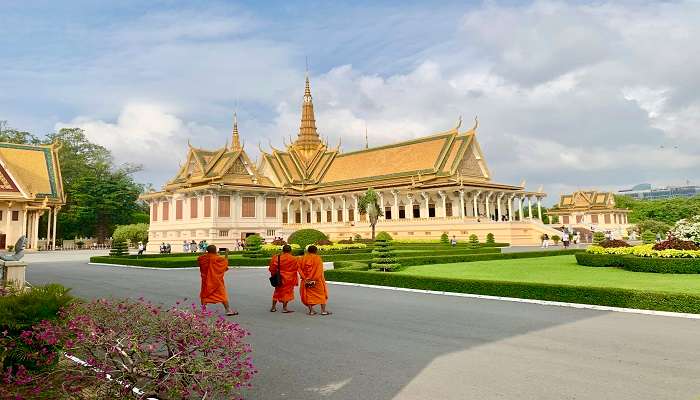
The best time to visit Wat Phnom Daun Penh in Phnom Penh is during the dry season, typically from December to May. During this time, the weather is generally pleasant, with lower humidity levels and minimal rainfall, providing optimal conditions for exploring the temple complex and its surroundings comfortably. Visitors can enjoy clear skies and mild temperatures, making it perfect for outdoor sports and sightseeing. However, it’s essential to remember that this period might also coincide with peak tourist season, so planning and arriving early can help avoid crowds.
Further Read: Kbal Spean
If you’re seeking an unforgettable cultural adventure, immerse yourself in the captivating charm of Wat Phnom Daun Penh and let its tranquillity embrace you. Book your trip to Cambodia today and set out on a voyage where the amazing riches of the nation will enchant you. Explore the timeless beauty of Wat Phnom Daun Penh and Cambodia’s other hidden gems – plan your unforgettable Cambodian adventure today!
For our editorial codes of conduct and copyright disclaimer, please click here.
Cover Image credit : By Pierre André for Wikimedia Commons.
Frequently Asked Questions About Wat Phnom Daun Penh
Why is Wat Phnom famous?
Wat Phnom is famous for two main reasons: its founding legend and its historical significance. Legend says a woman named Lady Penh found Buddha statues here in the 14th century, inspiring a temple and eventually the city named Phnom Penh ('Penh's Hill'). The temple itself is a cherished symbol of the city's spiritual heritage and one of the highest religious structures in Phnom Penh.
How big is Wat Phnom?
Wat Phnom stands tall at 46 meters (approximately 150 feet). Its impressive stature makes it a visible landmark in Phnom Penh. Its elevated location on an artificial hill enhances the pagoda's prominence and magnificence in the skyline.
What is Wat Phnom mountain?
Wat Phnom is situated on an artificial hill, which locals refer to as 'Wat Phnom Mountain.
What is the story of Daun Penh?
According to legend, in 1372, a wealthy woman named Daun Penh lived near the confluence of four rivers. One rainy day, she discovered a floating Koki tree in the river. To her surprise, the tree contained four Buddha statues made of bronze, brass, and marble. Additionally, there was a Vishnu statue. Inspired by this divine discovery, Daun Penh built a temple to house these sacred artefacts. Following her invitation for monks to bless the sculptures, the hermitage was dubbed 'Wat Phnom.
Is Wat Phnom free?
Yes, Wat Phnom is open to the public, and there is no entry fee. You can explore the shrine's grounds, admire the architecture, and soak in the spiritual ambience without cost.
People Also Read:
Lempuyang Temple Masceti Temple Mulgirigala Raja Maha Vihara

As a Travel Content Writer, I live to conquer the world of globetrotting with words. With my unquenchable thirst for storytelling, I believe that my words will inspire you to travel around the world’s breathtaking landscapes. As for me, I am an unapologetic selenophile, who loves to wander around in a starry night!











